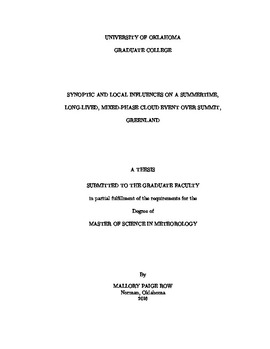| dc.description.abstract | Long-lived, Arctic mixed-phase clouds play a crucial role in modulating the surface energy balance over the Greenland Ice Sheet. However, due to temporally and spatially inconsistent observations, little is known about the mechanisms that cause their longevity. A persistent, single-layer, mixed-phase cloud was observed from 20-24 July 2012 at the “Integrated Characterization of Energy, Clouds, Atmospheric state, and Precipitation at Summit” (ICECAPS) cloud-atmosphere observatory in Summit Station, Greenland. The hypothesis in this study is motivated by \citet{morrison2012resilience}; this study investigates the hypothesis that local processes promote a cloud’s persistent state, while synoptic-scale processes influence the thermodynamic structure of the lower troposphere. This hypothesis is examined on the 20-24 July 2012 ICECAPS cloud event using the Weather Research and Forecasting model with polar modifications (Polar WRF) in a series of controlled experiments.
First, the role of the synoptic-scale processes is examined by fixing the boundary conditions to isolate the influence of the large-scale flow. Westerly winds over western Greenland and easterly winds over eastern Greenland, driven by a surface cyclone off southeastern Greenland, causes flow to converge atop the ice sheet, converse of the usual state due to the katabatic winds. This deeper vertical motion leads to the formation of ice rather that liquid water, leading to cloud dissipation. In the wake of the surface cyclone and moisture boundary, colder, drier air advects over Summit resulting in a very different thermodynamic profile in the boundary layer inhibiting the cloud from reforming.
Second, the role of local-scale processes is examined. An experimental simulation investigating the sensitivity of the cloud to its microphysics shows the cloud liquid water mixing ratio (cloud liquid water content) is sensitive to the ice mixing ratio. For lower ice mixing ratios, the cloud liquid water content is higher as a result of a less effective Wegner-Bergeron-Findeisen process. Another experiment looking at the sensitivity of the simulated cloud to the choice of planetary boundary layer scheme reveals that deeper mixing by larger eddies in the boundary layer is important for cloud maintenance.
Finally, the role of local processes is examined by modifying the cloud radiative forcings. In all simulations, the cloud forms at the surface as a result of strong surface radiative cooling under a surface-based inversion. Once the cloud forms, the radiative regime changes as there is now emission from the liquid water resulting in cloud-top longwave radiative cooling. This drives buoyancy-driven updrafts that elevate the cloud and result in two feedbacks: one, condensation of moist air near the surface maintaining the cloud liquid water and cloud-top longwave radiative cooling and two, a well-mixed layer that couples the cloud with the surface which maintains the cloud through moisture and energy contributions from the surface fluxes. The surface fluxes are also greater in the presence of the cloud as a result of the increased downwelling longwave flux at the surface from the cloud. As the strength of the cloud-top longwave radiative cooling is determined strongly by the cloud liquid water content, there exists a minimum amount of liquid water to drive strong enough cloud-top cooling and induced buoyancy-driven updrafts needed to one, maintain the cloud and two, elevate it from the surface. There is also a point where increasing the liquid water does not strengthen the above described processes. In addition, shortwave radiation does not significantly impact the cloud maintenance. However, there is some impact on the liquid content of the cloud; this can affect the amount of cloud-top longwave radiative cooling and its induced processes. | en_US |
